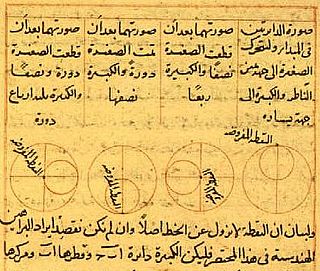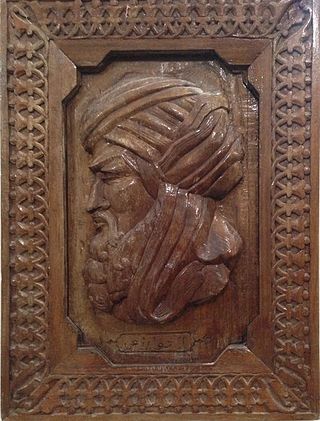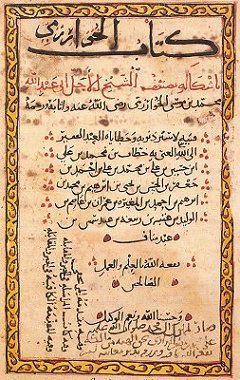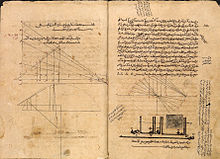Thābit ibn Qurra ; 826 or 836 – February 19, 901, was a polymath known for his work in mathematics, medicine, astronomy, and translation. He lived in Baghdad in the second half of the ninth century during the time of the Abbasid Caliphate.

Science in the medieval Islamic world was the science developed and practised during the Islamic Golden Age under the Umayyads of Córdoba, the Abbadids of Seville, the Samanids, the Ziyarids, the Buyids in Persia, the Abbasid Caliphate and beyond, spanning the period roughly between 786 and 1258. Islamic scientific achievements encompassed a wide range of subject areas, especially astronomy, mathematics, and medicine. Other subjects of scientific inquiry included alchemy and chemistry, botany and agronomy, geography and cartography, ophthalmology, pharmacology, physics, and zoology.

Algorism is the technique of performing basic arithmetic by writing numbers in place value form and applying a set of memorized rules and facts to the digits. One who practices algorism is known as an algorist. This positional notation system has largely superseded earlier calculation systems that used a different set of symbols for each numerical magnitude, such as Roman numerals, and in some cases required a device such as an abacus.
Abu'l Hasan Ahmad ibn Ibrahim Al-Uqlidisi was a Muslim Arab mathematician, who was active in Damascus and Baghdad. He wrote the earliest surviving book on the positional use of the Arabic numerals, Kitab al-Fusul fi al-Hisab al-Hindi around 952. It is especially notable for its treatment of decimal fractions, and that it showed how to carry out calculations without deletions.

Muḥammad ibn Mūsā al-Khwārizmī, or al-Khwarizmi, was a Persian polymath from Khwarazm, who produced vastly influential works in mathematics, astronomy, and geography. Around 820 CE, he was appointed as the astronomer and head of the library of the House of Wisdom in Baghdad.

Abu al-Saqr Abd al-Aziz ibn Uthman ibn Ali al-Qabisi, generally known as Al-Qabisi,, and sometimes known as Alchabiz, Abdelazys, Abdilaziz, was a Muslim astrologer, astronomer, and mathematician.
Muhammad ibn Ibrahim ibn Habib ibn Sulayman ibn Samra ibn Jundab al-Fazari was a Muslim Arab philosopher, mathematician and astronomer.
Alī ibn Aḥmad al-Nasawī was a Persian mathematician from Khurasan, Iran. He flourished under the Buwayhid sultan Majd al-dowleh, who died in 1029-30AD, and under his successor. He wrote a book on arithmetic in Persian, and then Arabic, entitled the "Satisfying on Hindu Calculation". He also wrote on Archimedes's Book of Lemmas and Menelaus's theorem, where he made corrections to the Book of Lemmas as translated into Arabic by Thabit ibn Qurra and last revised by Nasir al-Din al-Tusi.

Mahmūd ibn Muḥammad ibn Umar al-Jaghmini or 'al-Chaghmīnī', or al-Jaghmini, was a 13th or 14th-century Arab physician, astronomer and author of the Qanunshah a short epitome of by Avicenna in Persian, and Mulakhas (Summary), a work on astronomy.

Mathematics during the Golden Age of Islam, especially during the 9th and 10th centuries, was built on Greek mathematics and Indian mathematics. Important progress was made, such as full development of the decimal place-value system to include decimal fractions, the first systematised study of algebra, and advances in geometry and trigonometry.

Medieval Islamic astronomy comprises the astronomical developments made in the Islamic world, particularly during the Islamic Golden Age, and mostly written in the Arabic language. These developments mostly took place in the Middle East, Central Asia, Al-Andalus, and North Africa, and later in the Far East and India. It closely parallels the genesis of other Islamic sciences in its assimilation of foreign material and the amalgamation of the disparate elements of that material to create a science with Islamic characteristics. These included Greek, Sassanid, and Indian works in particular, which were translated and built upon.

The Hindu–Arabic numeral system or Indo-Arabic numeral system is a positional decimal numeral system, and is the most common system for the symbolic representation of numbers in the world.
The three brothers Abū Jaʿfar, Muḥammad ibn Mūsā ibn Shākir ; Abū al‐Qāsim, Aḥmad ibn Mūsā ibn Shākir and Al-Ḥasan ibn Mūsā ibn Shākir, were Persian scholars who lived and worked in Baghdad. They are collectively known as the Banū Mūsā.
Ibrahim ibn Sinan was a mathematician and astronomer who belonged to a family of scholars originally from Harran in northern Mesopotamia. He was the son of Sinan ibn Thabit and the grandson of Thābit ibn Qurra. Like his grandfather, he belonged to a religious sect of star worshippers known as the Sabians of Harran.
Qusta ibn Luqa, also known as Costa ben Luca or Constabulus (820–912) was a Syrian Melkite Christian physician, philosopher, astronomer, mathematician and translator. He was born in Baalbek. Travelling to parts of the Byzantine Empire, he brought back Greek texts and translated them into Arabic.
Abū Saʿīd Sinān ibn Thābit ibn Qurra, c. 880–943, was a medieval scholar who served as the court physician of the Abbasid caliphs al-Muqtadir, al-Qahir, and al-Radi.
A timeline of numerals and arithmetic.
This is a timeline of pure and applied mathematics history. It is divided here into three stages, corresponding to stages in the development of mathematical notation: a "rhetorical" stage in which calculations are described purely by words, a "syncopated" stage in which quantities and common algebraic operations are beginning to be represented by symbolic abbreviations, and finally a "symbolic" stage, in which comprehensive notational systems for formulas are the norm.
The Golden Age of Islam, which saw a flourishing of science, notably mathematics and astronomy, especially during the 9th and 10th centuries, had a notable Indian influence.
Na‘īm ibn Mūsā was a mathematician of the Islamic Golden Age and a pupil of Thabit Ibn Qurra. Na'im was from Baghdad and lived in the second half of the 9th century. He was the son of Muḥammad ibn Mūsā ibn Shākir, the oldest of the three brothers Banu Musa.









